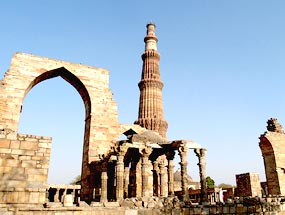Qutub Minar claims the distinction of being the
highest stone tower in India. Read about Qutab Minar of New Delhi,
India.
Qutub Minar

Location: New Delhi
Founded By: Qutub-ud-Din Aibak
Founded In: 1199
Status: UNESCO World Heritage Site
Qutub Minar, one of the most magnificent stone towers of the Indian
subcontinent, dates back to the time of Sultan Qutub-ud-Din Aibak. The
monument was built under the reign of the great Sultan and, his
son-in-law cum successor, Iltutmish. Its foundation was laid down in the
1199 and it was completed in three stages. The highest stone tower of
not only India, but also the whole world, Qutab Minar of New Delhi rises
to a height of approximately 72.5 meters. From the top to the bottom,
the monument has a total of 379 steps.
The minar narrows down from the bottom to the top. It has a diameter of
14.3 meters at the bottom, while at the top it comes down to only 2.7
meters. The entire edifice has been constructed with the help of red and
buff sandstone and serves as the perfect example of Indo-Islamic
architecture. Only the ground floor and the first floor of Qutub Minar
were constructed by Sultan Qutub-ud-Din Aibak. Later, Iltutmish added
three more floors to it. Projecting balconies, supported by stone
brackets, encircle all the floors of the monument.
These brackets have been adorned with honeycomb design, which is more
visible in those of the first floor. The first floor of the minar as
well as its balcony has a curved and fluted design. By the time we reach
the second floor, only the curved design remains, while the third floor
boasts of only the fluted design. Floral motifs and arabesques adorn the
monument, which was repaired by Firoz Shah Tughlaq and Sikandar Lodi.
The inscriptions on the surface of the floor tell us that Firoz Shah
renovated the top floor and added marble to the building.
All the artisans employed for the construction of Qutub Minar were
Hindus and even the raw material for the monument was obtained from
existing Hindu and Jain temples. Since human and animal figures are not
allowed in Islam, the motifs illustrating them were later disfigured.
There are a number of structures inside the complex of Qutab Minar, all
of which have been declared as World Heritage Sites by UNESCO.
Quwwat-ul-Islam Mosque
Quwwat-ul-Islam Mosque, constructed by Qutub-ud-Din Aibak, dates back
to the year 1198. The oldest mosque in the capital city built by the
Delhi Sultans, it stands on the site where once 27 Hindu and Jain
temples stood. These temples were razed to construct the mosque and one
can still see their carved columns and architectural appendages
supporting the cloisters of the mosque's courtyard. Later, Iltutmish and
Ala-ud-Din Khalji erected an arched screen and enlarged the mosque.
Iron Pillar
The Iron Pillar is situated inside the premises of the Qutub Minar
complex. It was constructed in the 4th century and bears an inscription
about its construction. The inscription states that the pillar was
constructed as a flagstaff, in the honor of Lord Vishnu and in the
memory of Chandragupta II, a Gupta King. The Iron Pillar is made of 98%
wrought iron and has lasted for 1,600 years without rusting.
Tomb of IItutmish
Iitutmish Tomb is a simple square chamber, which has been constructed
of red sandstone. Built in the year 1235, this monument stands carved
with inscription and geometrical and arabesque patterns in Saracenic
tradition, on its entrances as well as the whole interiors. It is said
that in the past, the tomb had a dome also. However, it fell down
because the walls could not stand its heavy weight.
Alai Darwaza
Alai Darwaza is the name given to the southern gateway of the
Quwwat-ul-Islam mosque. Ala-ud-Din Khalji got the gateway constructed in
the year 1311. It boasts of being the first gateway with a horseshoe
arch and true dome. Along with that, it was also the first structure,
which employed Islamic principles of construction and decoration.
Madrassa
A madrassa was also constructed by Ala-ud-Din Khalji, towards the
southwest of Qutub Minar. It was intended to provide religious education
to the children.
Alai Minar
Another one of Ala-ud-Din Khalji's constructions, Alai Minar was
intended to be double in size to the Qutub Minar. However, the monument
could not be fully completed. Only the first story, with a height of 25
m, was fully built. Alai Minar is situated to the north of the Qutub
Minar.


